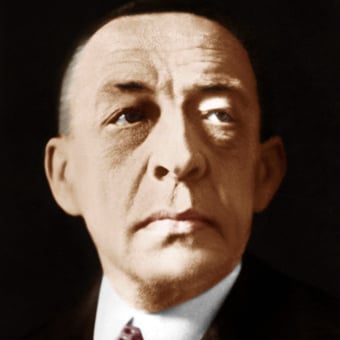
Sergei Rachmaninoff
d. 28 March 1943, Beverly Hills
Sergei Rachmaninoff, one of the greatest pianists of all time and one of the most outstanding melodists amongst composers, was born at Oneg, near Novgorod, on 20 March 1873 (1 April New Style), into a musical family: his grandfather had been a pupil of John Field and his father, too, played the piano. When Sergei was nine, financial difficulties forced the sale of the family estate and they moved to St Petersburg, where he took piano lessons at the Conservatoire. Rachmaninoff’s cousin, the pianist and conductor Alexander Siloti, had studied in Moscow with the strict Nikolai Zverev, and suggested that Rachmaninoff go to Zverev as well, and so in 1885, he made the journey to Moscow, staying with Zverev for three years. In 1888 Rachmaninoff began to study piano with Siloti himself and composition with Sergei Taneyev and Anton Arensky; he also received advice from Tchaikovsky, who was a friend of Siloti and his former teacher.
Even before his graduation as a pianist in 1891, Rachmaninoff had composed what was to become his best-known work, the Prelude in C sharp minor. His graduation as a composer came in 1892: he was awarded a gold medal for his Pushkin opera Aleko. The premiere of his First Symphony, in Moscow in 1897, was a disaster (word was that the conductor, Alexander Glazunov, was drunk), and Rachmaninoff destroyed the score (fortunately, a set of parts survived, which allowed the reconstruction of the score after Rachmaninoff’s death).
Rachmaninoff’s early career established a pattern he was to follow throughout his life: an uneasy struggle between performing and composing, with economic pressures usually ensuring that precedence needed to be given to the demands of the platform. He was an international figure as early as 1899, when he conducted a concert of his orchestral works in London, also playing some of his piano music.
Rachmaninoff began his Second Piano Concerto, one of the most frequently performed of all works in the genre, in 1900, completing it the following year, when his Cello Sonata was also composed. The little-heard cantata Spring followed in 1902, the year in which he married his cousin Natalya Satina; their daughter Irina was born in 1903. In 1904 Rachmaninoff took up a conductor’s post at the Bolshoi Opera in Moscow, stimulating the completion of two further operas, Francesca da Rimini and The Miserly Knight, in 1906. The pressures of conducting life in the Bolshoi persuaded the Rachmaninoffs to spend some time away from the capital, and they moved for a short while to Dresden, where he worked on his Second Symphony; Rachmaninoff himself conducted the premiere, in St Petersburg, in 1908.
The years up to the Russian Revolution were spent in an exhausting whirl of playing and conducting, with the family’s country estate at Ivanovka, in the countryside south-east of Moscow, offering a haven of peace where he could concentrate on composition. The works that emerged during this period include the Third Piano Concerto, the symphonic poem The Isle of the Dead, the choral symphony The Bells, and two a cappella choral works, the Liturgy of St John Chrysostom and the Vespers.
After the October Revolution in 1917 Rachmaninoff determined that he and his family would have to leave the country, and he accepted an invitation to perform in Stockholm. The composer, his wife and their two daughters left in December; he was never to return. They stayed briefly in Stockholm and Copenhagen, sailing to America in November 1918. There, his concertising increased, reducing his time for composition; he also began a career in the studio, producing recordings that eighty-odd years later are still regarded as some of the most valuable interpretations, of his own and others’ music, ever committed to disc.
Rachmaninoff sought to recreate the peace he had found at Ivanovka by building a villa on the shores of Lake Lucerne, far from the insistent pressures of the international concert circuit, and here he wrote the Rhapsody on a Theme of Paganini and the Third Symphony which, in 1939, he recorded with the Philadelphia Orchestra, which maintained a long association with his music. His last large-scale masterpiece was the Symphonic Dances, composed in 1940; at the time of his last recital, on 17 February 1943, in Knoxville, Tennessee, he was already gravely ill, and he died on 28 March, in Beverley Hills.
Rachmaninoff’s personal reserve was complemented by a deeply generous nature, which is reflected in the disciplined opulence of his music. Although his critical status fell somewhat during the post-War dominance of modernism, the affection in which his music was held by audiences never wavered, and now the critics are realising that the public was right all along: Rachmaninoff’s music often attains greatness – there is individuality in its harmonic richness, orchestral colouration and melodic warmth which will guarantee it a permanent and much-loved place in the repertoire.
Sergei Rachmaninoff is published by Boosey & Hawkes.
This biography can be reproduced free of charge in concert programmes with the following credit: Reprinted by kind permission of Boosey & Hawkes
